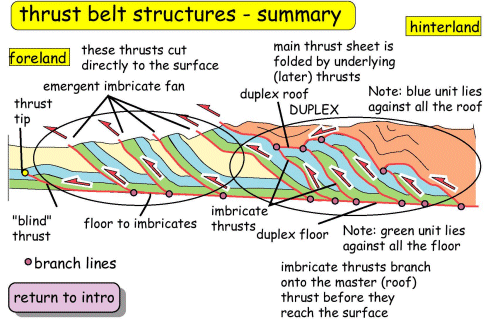

Thrust belts often look very complex but commonly they have a highly organised internal structure. We can use this organisation to help build up plausible cross-sections.
First off, note that thrusts are rarely planar and are commonly folded by later, underlying thrusts and associated fold structures. So never use a ruler to draw faults on a cross-section!
Duplex structures (those where all the thrusts diverge from a floor and recombine upwards onto a roof) have some key characteristics. The bottom of the duplex has rocks of the same unit all lying against the floor. So the oldest rock found in the duplex tells us the stratigraphic level at which the floor thrust glides. Rocks older than this should remain uneffected by the duplex at depth (in some situations we could simply project these beneath our cross section). Similarly the top of the duplex has rocks of the same unit lying directly beneath the roof. Look carefully - you'll see that in these ideal cases all thrusts still behave themselves, cutting up section in the direction of thrusting, placing older rocks upon younger ones.
Simple duplexes should follow these rules but beware: thrusts can change level along strike, and many upper thrusts are not true roof thrusts - rather they can decapitate duplexes slicing through the top of our well ordered structure.